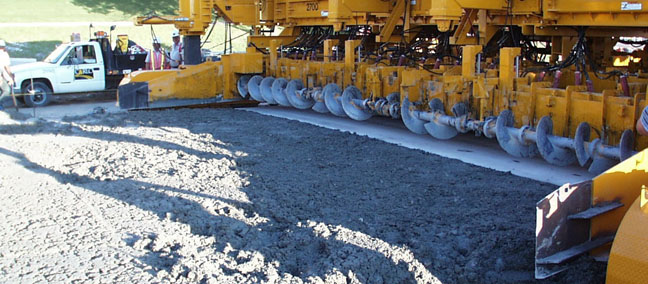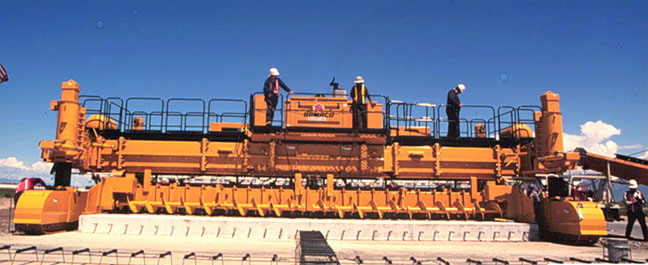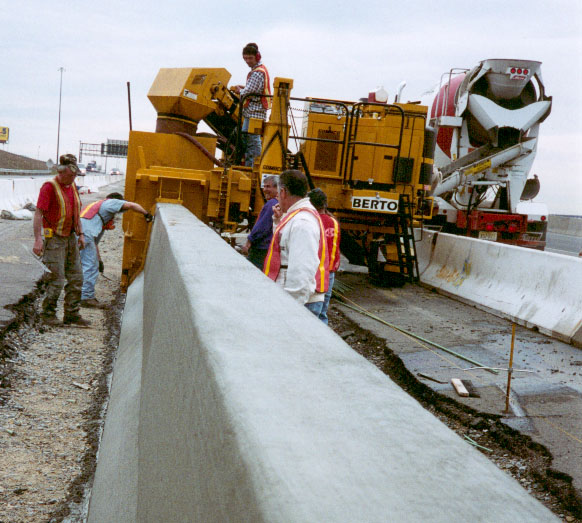GOMACO World Index --- GOMACO World 27.3 - September 1999
University Forum: Questions and Answers
By Dennis Clausen, Director of Training
Q. When starting to pave, what is the best way to come off a header or off an existing slab?
 A. The simplest way to start a new pour from a header is to have the header set 13mm (0.5 in) below the finished grade and to have each end cut approximately 25mm (one inch) short of the desired width. If possible, back the paver past the header 4.57 to 6.1m (15 to 20 ft). Lower the paver down onto grade and place all controls in the auto mode. Place concrete 203 to 254mm (8 to 10 in) above the existing slab along the full width of the header for a distance of about 3.05m (10 ft). Move the paver over the concrete and lower the vibrators into it. Vibrate the concrete for a short period without moving to completely consolidate the concrete around the header.
A. The simplest way to start a new pour from a header is to have the header set 13mm (0.5 in) below the finished grade and to have each end cut approximately 25mm (one inch) short of the desired width. If possible, back the paver past the header 4.57 to 6.1m (15 to 20 ft). Lower the paver down onto grade and place all controls in the auto mode. Place concrete 203 to 254mm (8 to 10 in) above the existing slab along the full width of the header for a distance of about 3.05m (10 ft). Move the paver over the concrete and lower the vibrators into it. Vibrate the concrete for a short period without moving to completely consolidate the concrete around the header.
When continuing the pour, the paving form will not fit over the slab due to the natural expansion of the concrete. If the form is equipped with hydraulic sideplates, raise them the maximum amount.Lower the paver until the form is just above the existing slab. Adjust all four grade sensors down (raising machine) approximately four turns on the jack. Make certain that the sensor indicators (on panel) are all centered or above center. As the  front of the paver moves forward off of the existing slab, return the front sensors to their original position. When the rear of the form has cleared the existing slab, adjust the rear sensors to their original position. If the form presses down too tightly on the existing slab when starting off, it may cause the edge or the end of the concrete to break off. If the form is equipped with the optional Vertical Hinged Sideplates, do not put pressure against the edge of the slab until the sideplates have cleared the end. Placing pressure on the sideplates too soon may cause the edges to break off.
front of the paver moves forward off of the existing slab, return the front sensors to their original position. When the rear of the form has cleared the existing slab, adjust the rear sensors to their original position. If the form presses down too tightly on the existing slab when starting off, it may cause the edge or the end of the concrete to break off. If the form is equipped with the optional Vertical Hinged Sideplates, do not put pressure against the edge of the slab until the sideplates have cleared the end. Placing pressure on the sideplates too soon may cause the edges to break off.
 Q. Why is it more difficult to pour barrier wall with fly ash in the mix than it is to pour without it?
Q. Why is it more difficult to pour barrier wall with fly ash in the mix than it is to pour without it?
A. The shape of the fly ash particles may cause part of the difficulty. Cement particles grow fuzzy during hydration and interlock together rapidly. This helps hold the concrete together. Fly ash particles are spherical and get fuzzy at a much slower rate. Therefore, they tend to react like marbles and roll apart. This is why it is much more difficult to get a mix with fly ash to stand up for a barrier wall.
Subscribe to Receive GOMACO World Magazine